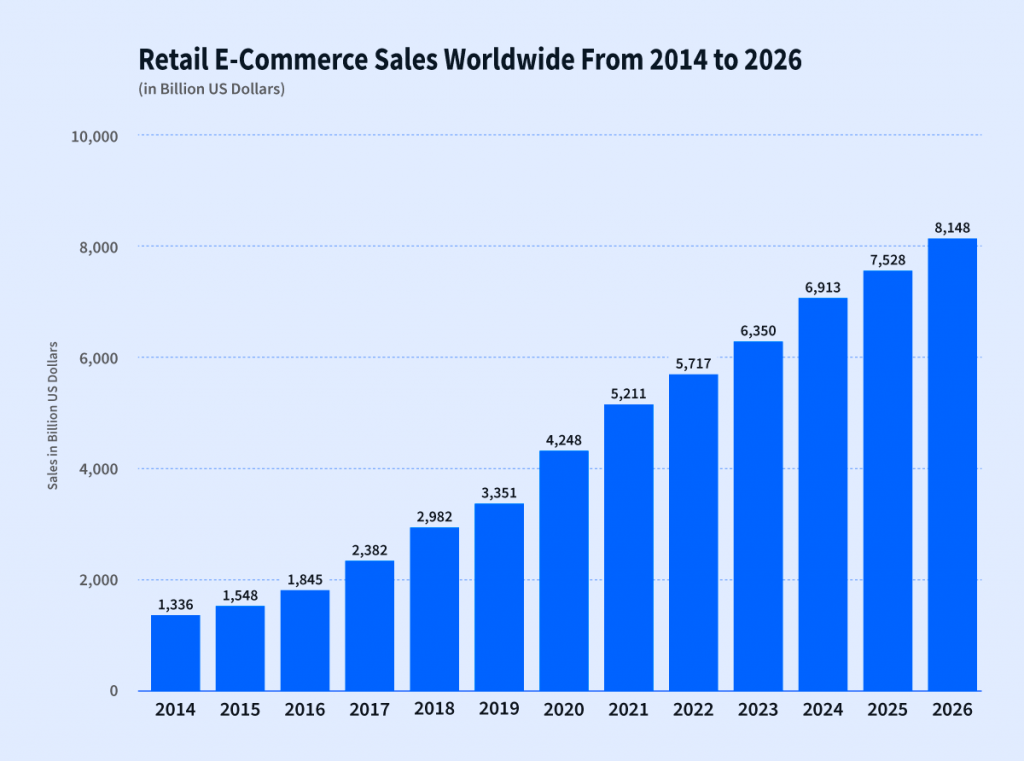E-commerce has become a vital part of consumer shopping habits. Thanks to technological advances, it’s easier than ever to browse online, buy online, and have your purchase delivered directly to your doorstep.
Programmatic advertising enables e-commerce brands to reach their consumers exactly where they are, which is online.
E-Commerce Spend is Growing
Pandemic restrictions in 2020 and 2021 definitely accelerated e-commerce adoption. Although restrictions have faded and some shoppers are returning to in-store shopping, e-commerce is now an established habit. Globally, spending on e-commerce continues to grow. It’s expected that from 2023 to 2026, global e-commerce sales will increase by 28%.

Programmatic Strategies For E-Commerce Campaigns
1. Understand Your E-Commerce Audience’s Journey
Journey mapping is the best way to understand your e-commerce audience’s journey from awareness to purchase. Journey mapping enables you to determine when you should be prospecting, running campaigns, retargeting prospects, and personalizing messaging. Ultimately, aligning your programmatic e-commerce campaigns with journey mapping will drive campaign success!
To map out the customer journey, you’ll need to gather industry and market audience data, look at your own primary data (if you happen to have some), and try to understand where you can intersect your audience.
Journey mapping not only tells you where to find your audience, but it can help you determine what their needs, problems, thoughts, and mindset is at every stage of the buying journey. This will help you determine what message to serve to your potential customers.
So, what is the journey of an online shopper? Although journey maps will vary depending on the product or service that’s being sold, most of them follow a version of this blueprint:
- Awareness: A shopper wants to purchase a new pair of socks. They click an ad for a type of sock that they’re searching for, or a related product that caught their attention.
- Consideration: The shopper browses an online store that carries socks.
- Purchase: The shopper buys the socks through an app or website.
- Retention: The shopper may respond to follow-up surveys or write a review.
- Loyalty: The shopper might tell others about the brand or join the affiliate program.
Journey mapping is about reaching the right audience, on the right channel or device, at the right moment, and with the right message.
Once you have mapped out the customer’s buying journey, you can identify the best time to capture their attention with an ad, ultimately increasing the probability that your industry targeting strategy will result in conversions.
A strong journey map will help to personalize your e-commerce strategy, so that the journey, and ultimately messaging, resonates with your ideal audience. The value of this personalization? Customer-centric companies are 60% more profitable than companies that aren’t.
2. Forecast E-Commerce Campaign Performance
Planning is key to every e-commerce campaign. In the planning stage, you’ll set your campaign goals, choose the right type of programmatic format, and make sure your programmatic platform has the desired audiences you need to launch your campaign. Part of that planning is also forecasting what the reach of your e-commerce campaign will look like based on these parameters.
Rather than going into a campaign with uncertainty, go in knowing that it will deliver on a specific metric. By making adjustments before your campaign starts, you ensure that the campaign with run and won’t struggle with pacing.
Forecasting provides you with data-driven insights that enable you to anticipate campaign performance prior to running live—in a way, you can pre-optimize your campaign. It’s simple to use, which makes it an easy step to add to your campaign planning.
By predicting campaign results ahead of time, you can make sure you’re planning the parameters that will help you reach the right audience, and maximize the impact of your ad dollars. And, you might even discover opportunities for ad spend that you may have not even realized were an option.
3. Choose the Right Targeting Tactics
Targeting plays a key role in the success and performance of campaigns. For e-commerce campaigns, the right targeting tactics help ensure you reach the right audiences, at the right time.
Contextual Targeting
Contextual advertising leverages the context next to which the ad appears to deliver highly-relevant ads to the right audience, at the right moment. There are various tactics available for contextual advertising.
For example, Page Context AI drives campaign performance by leveraging artificial intelligence (AI) to place ads in the right context, expanding targeting to include highly-relevant phrases related to the context.
Another tried-and-true strategy is contextual keyword targeting, which puts you in control by allowing you to indicate the exact keywords you’d like your campaign to match with. Brands can also repurpose their search keywords to define a custom keyword browsing or contextual audience (can include competitor keywords).
Audience Lookalike Targeting
Lookalike audiences enable you to create a list of users who mimic the online behaviours of those who have visited your site previously. A pixel is implemented to build lookalike audiences, which you can then fine-tune even further by creating a lookalike segment based on users who converted on your website.
Lookalike audiences will ensure that your e-commerce campaigns reach relevant users who have characteristics that align with your already existing customers. It’s a perfect strategy for extending your retargeting pool because you expand beyond the users who have visited your site.
4. Use a Multi-Channel Approach
Multi-channel campaigns are essential for e-commerce advertising. These campaigns make it possible to reach users across different platforms and channels. A multi-channel strategy is key in today’s digital landscape because online shoppers are active across various channels and devices.
Understanding how shoppers are interacting across platforms is central to learning how you can effectively reach them, and reach your campaign goals. You can run digital marketing for your e-commerce brand across two channels, like video and programmatic audio, or across more channels including connected TV (CTV) and digital out-of-home (DOOH).
Leveraging multiple channels helps you to gain a larger reach by capturing consumers who might only be on some channels. With the right mix of complementary channels, you can increase the percentage of the total target audience that you can reach. And, it helps you to craft a cohesive message across all of the included channels.
5. Leverage Rich Media Ads to Capture Attention
Rich media ads are creative ad formats that have interactive features. An interactive ad invites the user to perform an action in order to have something revealed within the ad itself or to navigate towards a specific landing page.
Whether the action is hovering or clicking, the audience is typically given instruction to explore the ad for more details. This interactive-viewer experience is a unique way to uplift and complement your digital strategy. Using rich-media ads in your programmatic e-commerce campaigns will help to capture attention from your target audience and build awareness for your brand.
These are some interactive creative formats that you can use in your e-commerce campaigns:
Discovery Ads
Use discovery ads to pose a question to the user. This can determine their interests or opinions based on a topic you’ve chosen. All clicks can be tracked to create retargeting pools and products in the carousels can click out to unique product pages to reduce the path to conversion.
Shoppable Video
This ad format showcases products in use while allowing the user to browse right in the banner. Shoppable video ads reduce the steps that a user must take between awareness and conversion. Products can click out directly to their individual pages for a frictionless shopping experience.
Dynamic Countdown Ads
With countdown ads, you can make sure your audience is aware of your sales and promotions. And a dynamic countdown unit will help create a sense of urgency for your audience to perform an action.
Interactive ads like these help to boost brand awareness and bring extra benefits too: They provide much needed convenience for consumers. As product discovery moves online, rich media ads can be leveraged to help you find out who your audience is, guide shoppers closer to a purchase, and to provide insights on the customer journey.
6. Use Dynamic Retargeting for E-Commerce
Leveraging retargeting will deliver online ads to users or consumers based on their previous, intent-based actions on the web. This is an important tactic for re-engaging online shoppers who previously showed interest in your brand or products. By re-engaging them, you can move them down the funnel toward a conversion.
Dynamically retarget individuals with personalized native or display ad content based on the nature of their prior website engagement or activity. If someone has browsed through your product offerings, continue to remind them of what they’re interested in throughout their online journey.
Programmatic Advertising for Winning E-Commerce Campaigns
For any e-commerce campaign, you’ll want to take the time to understand your audience’s journey, and leverage forecasting for your campaign’s planning stage. From there, choosing the right targeting tactics, using rich-media ads, dynamic retargeting, and taking a multi-channel approach will drive e-commerce campaign performance.
Want to run exceptional programmatic campaigns? Request a demo to learn more about StackAdapt.





